Botanical Garden
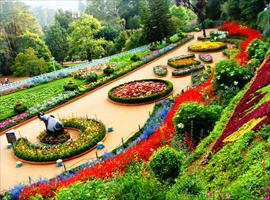
The botanical garden in Srinagar, Jammu and Kashmir, India, is set up in 1969 in the memory of India's first prime minister. It contains many types of plants and vegetation. This garden has a collection of about 1.5 lakh ornamental plants and a huge collection of oak varieties. It also has a rare collection of Kashmiri tropical plants.This garden is located on the side of a mountain and near to Chashma Shahi, Roop Bhavani Temple, etc. Many people from various areas of world visit this place. It has four main divisions: the Plant Introduction Centre, the Research Section, the Recreational Garden and the Botanical Garden.
|
Shalimar
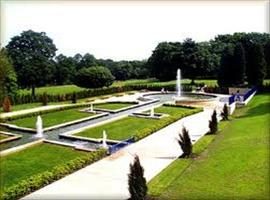
Shalimar Bagh is a Mughal garden in India, linked through a channel to the northeast of Dal Lake, on its right bank located near Srinagar city in Jammu and Kashmir. Its other names are Shalamar Garden, Shalamar Bagh, Farah Baksh and Faiz Baksh, and the other famous shore line garden in the vicinity is Nishat Bagh. The Bagh was built by Mughal Emperor Jahangir for his wife Nur Jahan, in 1619. The Bagh is considered the high point of Mughal horticulture. It is now a public park.
Shalimar Bagh has three terraces as per its architecure is concerned:
The first terrace is a public garden or the outer garden ending in the Diwan-e-Aam (public audience hall). In this hall, a small black marble throne was installed over the waterfall.
The second terrace garden along the axial canal, slightly broader, has two shallow terraces. The Diwan-e-Khas (the Hall of Private Audience), which was accessible only to the noblemen or guests of the court, now derelict, is in its centre. However, the carved stone bases and a fine platform surrounded by fountains are still seen. The royal bathrooms are located on the north-west boundary of this enclosure. The fountain pools of the Diwan-e-Khas, the Diwan-e-Aam, and in turn, the Zenana terrace ae supplied in succession. It has 410 fountains.
In the third terrace, the axial water channel flows through the Zenana garden, which is flanked by the Diwan-e-Khas and chinar trees. At the entrance to this terrace, there are two small pavilions or guard rooms (built in Kashmir style on stone plinth) that is the restricted and controlled entry zone of the royal harem. Shahajahan built a baradari of black marble, called the Black Pavilion in the zenana garden. It is encircled by a fountain pool that receives its supply from a higher terrace. A double cascade falls against a low wall carved with small niches (chini khanas), behind the pavilion. Two smaller, secondary water canals lead from the Black Pavilion to a small baradari. Above the third level, two octagonal pavilions define the end wall of the garden. The baradari has a lovely backdrop of the snow mountains, which is considered a befitting setting for the Bagh.The Shalimar Bagh is well known for chini khanas, or arched niches, behind garden waterfalls. They are a unique feature in the Bagh. These niches were lighted at night with oil lamps, which gave a fairy tale appearance to the water falls. However, now the niches hold pots of flower pots that reflect their colours behind the cascading water.
Another unusual architectural feature mentioned is about the doors of the Baradari. In the garden complex, the Baradari had four exquisite doors made of stones supported by pillars. It is conjectured that these stone doors were ruins from old temples that were demolished by Shahajahan. The garden also provided large water troughs where a variety of fountains were fixed.
|
Nishat
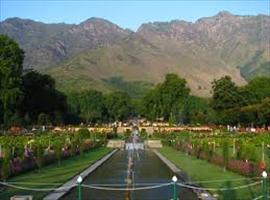
Nishat Bagh is a terraced Mughal garden built on the eastern side of the Dal Lake, close to Srinagar in the state of Jammu and Kashmir, India. It is the second largest Mughal garden in the Kashmir Valley. The largest in size is the Shalimar Bagh, which is also located on the bank of the Dal Lake. "Nishat Bagh" means "Garden of Joy", "Garden of Gladness" and "Garden of Delight.Located on the bank of the Dal Lake, with the Zabarwan Mountains as its backdrop, Nishat Bagh is a garden of bliss that commands a magnificent view of the lake beneath the snow-capped Pir Panjal mountain range that stands far away to the west of the valley. The Bagh was designed and built in 1633 by Asif Khan, elder brother of Nur Jehan.When Shah Jahan saw this garden, after its completion in 1633, he expressed great appreciation of its grandeur and beauty. He is believed to have articulated his appreciation three times to Asif Khan, his father-in- law, with the hope that he would gift it to him.
|
Doodhpathri
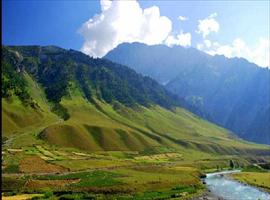
Doodhpathri is situated at an altitude of 2730m above sea level in the south-west of Kashmir valley. Lofty mountains, sky touching trees, velvet-like green meadows, crystal-clear water and life-giving air all make Doodhpathri an unmatched and unparalleled Tourist Destination. Doodhpathri means milky water that flows in its rivers. The water flows very fast. When it strikes against the stones, it forms a milky-white appearance; hence the name- Doodhpathri. A flowing river resounds with soft wind passing through the pine trees of the enclosures of the valley. It is also called as a "valley of milk" because it produces rich milk in large quantity.
|
Sonamarg
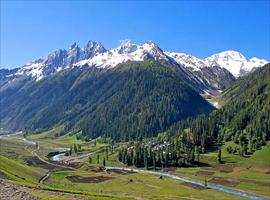
Sonamarg, means "Meadow of Gold" is a hill station in Ganderbal district in Jammu and Kashmir. In its vicinity lies the great Himalayan glaciers of Kashmir Valley namely Kolhoi Glacier and Machoi Glacier with some peaks of above 5000 meters: Sirbal Peak, Kolhoi Peak, Amarnath Peak and Machoi Peak. Sonamarg an alpine valley is situated at the bank of Nallah Sindh, 87 km north-east from Srinagar, it is a popular tourist destination, nestled with in the imposing Himalayan peaks. It lies at an altitude of 2800 metres above sea level. The drive to Sonamarg is through yet another spectacular facet of country side in Kashmir, this time its the Nallah Sindh, the largest tributary of the Jehlum River in the valley of Kashmir. It is upwards of sixty miles long valley and deep rock-girt gorge to open grassy meadow land and village-dotted slopes. Sonamarg, which means "meadow of gold " has, as its backdrop, snowy mountains against a cerulean sky. the Sindh meanders along here and abounds with trout and mahseer, snow trout can be caught in the main river. In late April when Sonamarg is open for road transport, the visitors can have access to snow which is furnished all over like a white carpet. Ponies can be hired for the trip up to Thajiwas glacier a major attraction during the summer months. The climate of Sonamarg is very bracing; but the rainfall is frequent though not heavy, except for two or three days at a time in July and August with fine spell in between. From Sonamarg, trekking routes lead to the Himalayan lakes of Vishansar Lake, Krishansar Lake, Gangabal Lake and Gadsar Lake, stocked with Snowtrout and Brown trout and Satsar, glacier-fed and surrounded by banks of alpine flowers.A close by excursion is to Baltal, 15 km East of Sonamarg. This little valley lies at
the foot of the Zojila, only a day's journey away from the sacred cave of Amarnath is a base camp for Amarnath yatra. Trekkers can also reach the starkly splendid roof-top of the world Leh, by crossing over the Zoji La pass.
|
Pahalgam
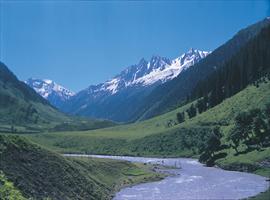
Pahalgam is a town and a notified area in Anantnag district of Jammu & Kashmir. It is a popular tourist destination, and every year, many tourists visit Pahalgam. This world famous hill station is 45 km. from the District Headquarters at Anantnag and located on the banks of Lidder River at an altitude of 7200 ft. from sea level. Pahalgam is one among the five tehsils of Anantnag district and tehsil headquarters are located in the main town of Pahalgam. Besides tourist huts, several hotels in private sector have come up here and these hotels provide modern facilities to their guests. A number of treks in this region also begin from Pahalgam, as the 35 km trail traverses through pinewoods to the spectacular Kolahoi Glacier.Pahalgam is also associated with the annual Amarnath Yatra. Chandanwari (2,895 m), 16 km from Pahalgam, is the starting point of the yatra that takes place every year in the month of Sawan (July to August). The road from Pahalgam to Chandanwari is on fairly flat terrain and can be undertaken by car. From Chandanwari onwards the track becomes much steeper, and is accessible on foot or by pony. About 11 km from Chandanwari is the mountain lake of Sheshnag (3,574 m), after which, 13 km away is the last stop, Panchtarni. The Amarnath cave is 6 km from there.
Pahalgam has an average elevation of 2740 metres (8989 feet). Betaab Valley is a very famous tourist spot situated at a distance of 15 kilometers from Pahalgam. The Valley is towards northeast of Pahalgam and falls between Pahalgam and Chandanwadi and is en route Amarnath Temple Yatra. The valley is surrounded by lush green meadows, snow clad mountains and covered with dense vegetation.
|
Gulmarg
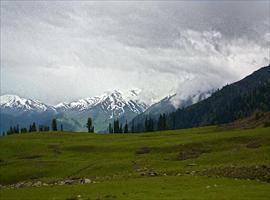
Gulmarg, also called "Meadow of Flowers" is a town, a hill station, a popular skiing destination and a notified place of Baramula district in Jammu and Kashmir. The town is within the Himalayas. Gulmarg is located 52 km from Srinagar. It is located at 34.05°N 74.38°E. It has an average elevation of 2,690 m (8,825 ft).Gulmarg has been a resort for the kings like Yousuf Shah Chak and Jahangir who used to visit frequently. GULMARG, means, the place of roses. Gulmarg is easily accessible from Srinagar or Srinagar Airport, the capital of Kashmir, in under 2 hours by car or bus. Just 1 hour on the way is the town of Tangmarg, a key tourist attraction and also a main destination for skiers riding down from Gulmarg during the winter months. From Tangmarg, the Gulmarg plateau is just 30 minutes travel.The peak season starts with the snowfall in December and lasts until April. Gulmarg is the "heartland of winter sports in India." Gulmarg was being mooted as a possible host for the 2010 Commonwealth Winter Games. As such, Gulmarg has been rated by CNN International as Asia's seventh best ski destination. This resort is famous because of its "Gulmarg Gondola," one of the highest cable car in the world, reaching 3,979 metres. The two-stage ropeway ferries about 600 people per hour to and from the gondola main station in Gulmarg to a shoulder of nearby Mt. Apharwat Summit (4,200 m (13,780 ft)).
|